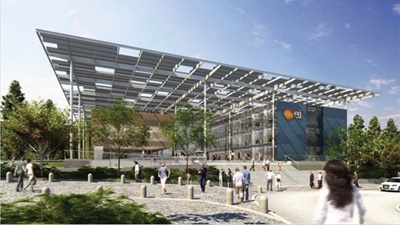Second pillar of pan-European Extreme Light Infrastructure project to receive€180 M in structural funds.
 ELI:the first pillar
ELI:the first pillar
The European Commission(EC)has approved€180 million in structural funding to support the construction of a giant new laser facility in Romania.
Part of the wider"Extreme Light Infrastructure"projects that are intended to stimulate research and development in eastern Europe,Romania is to host a facility designed to push the boundaries of laser-based nuclear physics by coupling a high-energy particle accelerator with a high-power laser.
The Extreme Light Infrastructure–Nuclear Physics(ELI-NP)project will be based in the area of Magurele,south of the Romanian capital Bucharest,and is scheduled to become operational in 2015.The EC's funding covers the first phase of the project,running 2011-2015,while the total cost of the project is expected to reach€356.2 million.
Johannes Hahn,the EC's commissioner for regional policy,said:"This is exactly the type of project we want to see more of in the future.It is aimed at boosting research and innovation with a clear European Union added value,to ensure that each and every euro is wisely spent."
ELI-NP is the second of the so-called"pillars"of the ELI to receive approval from Brussels.Last year the EC approved€236 million to fund the first of the ELI pillars,a facility to be built near Prague in the Czech Republic that will provide ultrafast bursts of highly energetic particles from what are described as compact laser plasma accelerators.
Overall,the ELI project is expected to require some€700 million in funding from the EC.As part of the wider plan,a laser capable of producing high-intensity pulses of light in the attosecond regime is also slated for Hungary,although this facility is yet to receive structural funding.
Halting the"brain drain"
Once built and operational,the Romanian laser facility will serve as a pan-European laboratory supporting fundamental studies of nuclear physics and astrophysics,as well as advances in materials science and medicine.Research teams at the site will also look at new ways to handle radioactive waste.
Along with the rest of the ELI project,the site should also help to reverse the"brain drain"of highly qualified scientists and engineers away from eastern Europe,and attract new companies to the region.
"We have very high hopes for the ELI-NP project,"Hahn added."Through it,Romania has a chance to put itself firmly on the map of European research and to retain highly specialized workers."
One of the EC's wider aims is to ensure that the European Union as a whole is investing 3%of GDP in research and development activity by 2020.At the moment the figure for Romania is only 0.5%,and the EC has set a target of 2%for the country by the end of the decade that should be aided by the ELI project.
"ELI-NP is expected to give a much-needed boost to research and development in Romania,helping the country to bridge the innovation gap and foster knowledge and technology transfer,"the EC added."This project is also expected to considerably enhance the attractiveness of Romania as a location for research excellence and innovation."
The EC money for the project is being provided through the European Regional Development Fund,which is used to provide direct aid to companies,and SMEs in particular,as well as major infrastructure projects like the ELI.
The light source for the Romanian facility is expected to comprise at least two"Apollon"type Ti:sapphire lasers,each capable of 10 PW power levels using the chirped-pulse amplification technique pioneered at the University of Rochester in the 1980s.
Output intensities of up to 1024 W/cm2 will be used in combination with an electron beam to generate high-energy photons capable of interrogating atomic nuclei.





